“Hallelujah” by Leonard Cohen is a timeless, emotionally rich song with deep lyrical complexity, rendered iconic through its piano arrangements, resonating universally across generations and cultures alike.
Background and History of the Song

Background and History of the Song
Leonard Cohen wrote “Hallelujah” in 1984 for his album Various Positions. The song’s lyrical depth, blending biblical references with personal emotion, initially received limited recognition but gained fame over time. Its poetic complexity and universal themes resonated deeply, making it a modern classic. Despite its slow rise, “Hallelujah” became iconic, especially after Jeff Buckley’s 1994 rendition. Over 200 recorded versions exist, showcasing its timeless appeal. The piano arrangement captures its emotional essence, making it a sought-after piece for pianists. Its evolution from obscurity to global acclaim highlights its enduring musical and lyrical significance.
Leonard Cohen and His Legacy
Leonard Cohen and His Legacy
Leonard Cohen, a renowned Canadian poet, novelist, and singer-songwriter, crafted “Hallelujah” in 1984 for his album Various Positions. His work, known for its literary depth and emotional resonance, has left an indelible mark on music and literature. Cohen’s legacy is celebrated through his inductions into the Canadian Music Hall of Fame and the Canadian Songwriters Hall of Fame. His ability to weave complex themes into music earned him the Companion of the Order of Canada. Over 200 renditions of “Hallelujah” highlight its timeless appeal, solidifying Cohen’s impact as a cultural icon whose artistry continues to inspire globally.
The Timeless Appeal of “Hallelujah”
“Hallelujah” captivates audiences with its profound emotional depth and poetic complexity, blending sacred and secular themes. Its universal appeal lies in Cohen’s masterful storytelling, evoking love, spirituality, and human struggle. The song’s versatility shines through countless renditions, from Jeff Buckley’s haunting interpretation to orchestral arrangements. Its presence in films, TV shows, and cultural moments has cemented its status as a modern classic. The piano score, in particular, underscores the song’s intimacy and grandeur, making it a favorite among musicians and listeners alike. This timeless piece continues to resonate, transcending generations and genres, ensuring its enduring relevance in music history.

The Piano Score
The piano score of “Hallelujah” captures the song’s emotional essence, featuring a haunting melody in F Major. Its arrangement emphasizes dynamics and tempo variations, creating a powerful yet intimate performance experience.
Structure and Composition of the Score
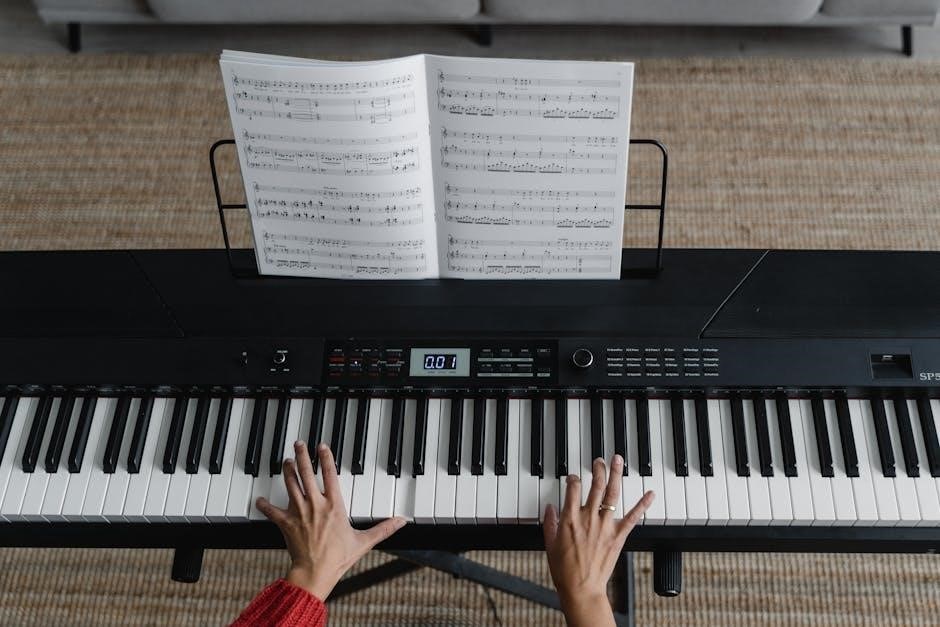
Structure and Composition of the Score
The piano score of “Hallelujah” is structured in a verse-chorus format, with a haunting melody that flows over a simple yet powerful harmonic progression. The song is typically written in F Major, spanning three pages, and features a moderate tempo of 56 beats per minute. The composition emphasizes dynamic contrasts, with soft arpeggios in the verses building to emotive crescendos in the choruses. The arrangement includes intricate chord progressions, such as G, Em, and Dm, which create a sense of tension and resolution. The score also incorporates lyrical phrasing, with the piano mirroring the vocal melody to enhance the song’s emotional depth. This structure makes it accessible for intermediate pianists while offering complexity for advanced interpretations, ensuring its timeless appeal.
Key Elements of the Piano Arrangement
Key Elements of the Piano Arrangement
The piano arrangement of “Hallelujah” centers around a haunting melody with arpeggiated chords, creating a lush yet intimate sound. The score features a mix of legato and staccato playing, adding emotional depth. Chord progressions like G, Em, and Dm are central, providing harmonic richness. Dynamics range from soft, delicate verses to powerful choruses, enhancing the song’s emotional journey. The arrangement often includes suspended chords and minor keys, amplifying the song’s reflective nature. Additionally, the piano mirrors the vocal melody, creating a sense of unity between voice and instrument. These elements make the arrangement both expressive and accessible, appealing to pianists of various skill levels while preserving the song’s iconic feel.
Challenges in Transcribing the Song for Piano
Transcribing “Hallelujah” for piano presents unique challenges, such as capturing the song’s emotional depth and complexity. The original vocal and guitar arrangement must be adapted to piano while preserving the haunting melody and chord progressions. Dynamics and tempo variations require precise handling to maintain the song’s essence. Additionally, the transcriber must choose between various versions, including Leonard Cohen’s original and Jeff Buckley’s popular cover, each with distinct arrangements. Ensuring clarity in notation and playability for pianists of different skill levels adds to the complexity. Legal considerations, such as copyright, also play a role in creating an accurate and accessible piano score.
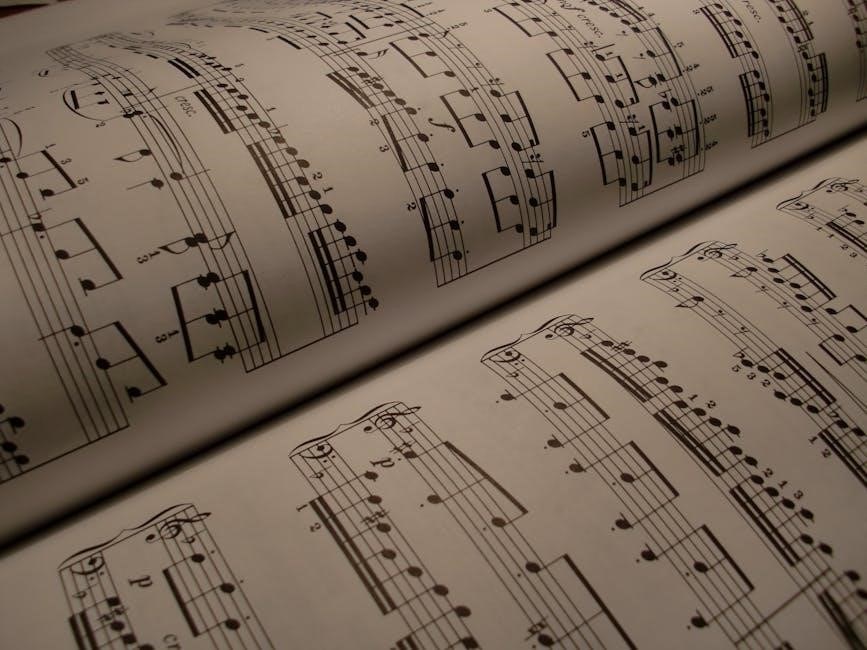
Where to Find the “Hallelujah” Piano Score PDF
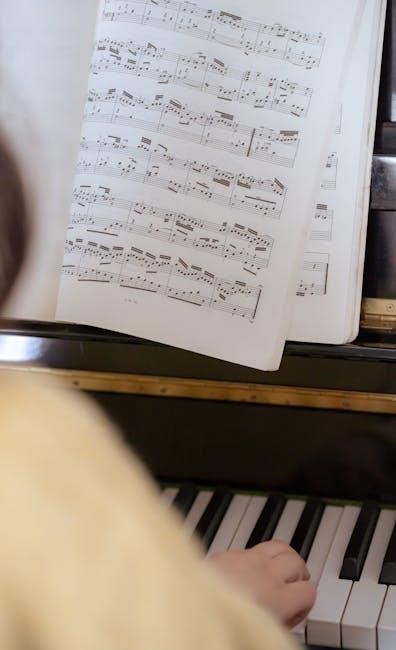
The “Hallelujah” piano score PDF can be found on official sites like Sheet Music Direct and Musicnotes, offering high-quality, legal downloads. Free versions are available on platforms like MuseScore, Reddit’s r/SheetMusic, and other community-driven sites, though users should be cautious about copyright and quality. Always ensure legality when downloading sheet music.
Official Sources and Licensed Distributors
Official sources like Sheet Music Direct and Musicnotes offer high-quality, legally licensed “Hallelujah” piano score PDFs. These platforms provide accurate arrangements, ensuring authenticity and quality. Licensed distributors like Sony/ATV Songs LLC guarantee that downloads support the creators and adhere to copyright laws. Users can access transposable sheet music in various keys, suitable for pianists of all skill levels. These official sources are reliable and provide seamless downloads, making them the best choice for those seeking professional and legal sheet music.
Free Resources and Community Platforms
Free “Hallelujah” piano score PDFs can be found on platforms like SheetMusic-Free.com and MuseScore, where users share arrangements. Communities such as Reddit’s r/SheetMusic also host shared scores. These resources are ideal for enthusiasts and learners seeking accessible versions. While free, some arrangements may be simplified or unofficial. Always verify legality and consider supporting creators by purchasing licensed versions when possible. These platforms foster collaboration and provide diverse interpretations, making them invaluable for musicians seeking inspiration or practice material.
Legal Considerations in Downloading Sheet Music
Downloading “Hallelujah” piano score PDFs requires attention to copyright laws. Official sources like Leonard Cohen’s publisher or licensed distributors ensure legal access. Free platforms may offer sheet music, but these are often unauthorized, risking legal consequences. Unauthorized downloads violate intellectual property rights and may harm creators. Always verify the source’s legitimacy to avoid legal issues and support artists. Purchasing from reputable sites is the lawful way to obtain high-quality sheet music, ensuring both compliance and fairness to the creators. Respect copyright by choosing licensed versions to enjoy “Hallelujah” responsibly.

How to Play the “Hallelujah” Piano Score
Start with a slow tempo, focus on chord voicings, and gradually incorporate dynamics. Practice arpeggios and melodic lines to capture the song’s emotional depth effectively.
Tips for Beginners
Begin by practicing the melody slowly, focusing on chord progressions in the original key of C Major. Start with a simple arrangement, using basic chords like G, Em, and C. Break the piece into sections, mastering one part at a time. Pay attention to dynamics and timing, as these enhance the song’s emotional impact. Use online tutorials or video guides to help with tricky sections. Begin with a metronome set to a slow tempo, gradually increasing speed as confidence grows. Emphasize playing with feeling, as “Hallelujah” is deeply expressive. Consider using sheet music apps or tools to slow down or loop difficult passages for better practice.
Intermediate Techniques to Enhance Performance
For intermediate players, refining finger independence and dynamics is key. Experiment with arpeggio patterns to add texture, particularly in the verse sections. Incorporate subtle chord voicings, such as suspended or major seventh chords, to enhance harmonic richness. Pay attention to pedaling techniques—sustain and sostenuto pedals can deepen the song’s emotional impact. Introduce rubato to convey the lyrical phrasing, allowing for expressive timing variations. Practice playing with a steady rhythm in the verses and build intensity in the choruses. Adding grace notes or melodic fills can personalize your interpretation while staying true to the song’s essence. Focus on balancing technical skill with emotional expression to capture the song’s haunting beauty.
Advanced Interpretations and Variations
Advanced pianists can elevate “Hallelujah” by experimenting with complex harmonies, chromatic passages, or unconventional scales to deepen its emotional layers. Incorporating jazz-inspired improvisations or modal interchange can offer a fresh perspective. Consider altering the song’s structure by introducing dramatic pauses or tempo shifts to build tension. Dynamic contrasts, such as transitioning from delicate arpeggios to powerful chordal sections, can intensify the performance; Exploring polyrhythms or dissonant harmonies adds a modern twist while maintaining the song’s essence. For inspiration, study arrangements by classical or jazz artists, as their interpretations often reveal innovative approaches to this timeless piece.
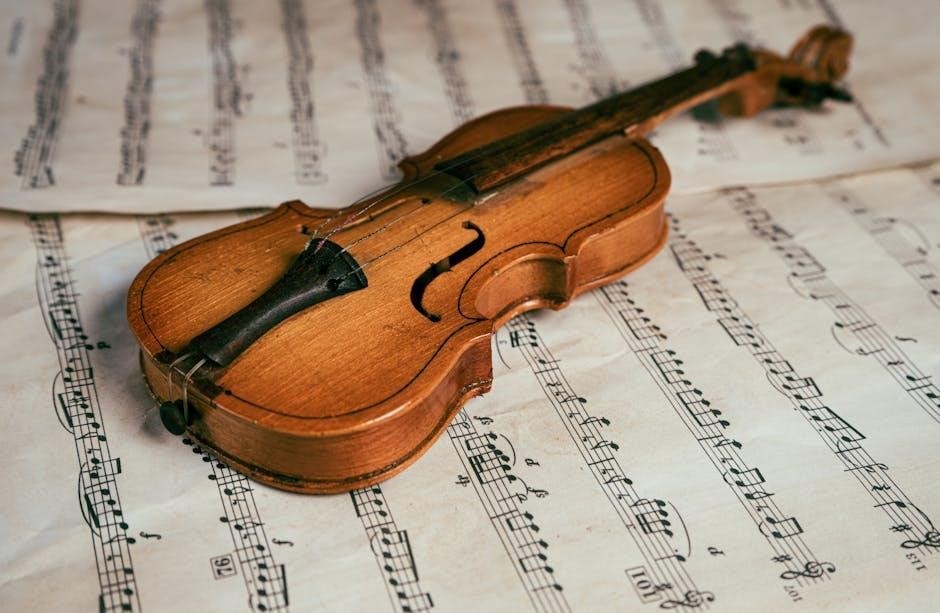
Different Versions and Arrangements
From Jeff Buckley’s iconic rendition to instrumental and vocal reinterpretations, “Hallelujah” offers vast creative possibilities, with arrangements spanning piano, guitar, orchestral, and choral adaptations worldwide.
Jeff Buckley’s Iconic Version
Jeff Buckley’s rendition of “Hallelujah,” featured in his 1994 album Grace, is widely regarded as the definitive version, capturing the song’s emotional depth with haunting vulnerability. Buckley’s voice, accompanied by a simple yet powerful piano arrangement, elevates the track to a timeless classic. His interpretation infuses the lyrics with raw emotion, making it deeply personal and universally resonant. The piano score for this version is highly sought after, as it perfectly complements Buckley’s vocal delivery. Fans and pianists alike treasure this arrangement for its ability to convey the song’s intricate emotional layers. Buckley’s “Hallelujah” remains a benchmark for all subsequent covers, solidifying its place in musical history.
Other Notable Covers and Their Influence
Beyond Jeff Buckley’s iconic version, “Hallelujah” has been masterfully covered by numerous artists, each bringing unique interpretations. John Cale’s minimalist piano arrangement and Rufus Wainwright’s emotive vocals offer distinct perspectives, while Regina Spektor adds a quirky, intimate touch. These covers not only honor Leonard Cohen’s original but also expand the song’s reach, appealing to diverse audiences. Their interpretations highlight the track’s versatility, making it a staple across genres. Such varied renditions ensure “Hallelujah” remains timeless, inspiring both musicians and listeners to explore its depth and beauty continually. Each cover enriches the song’s legacy, showcasing its enduring emotional resonance and artistic adaptability.
Instrumental and Vocal Arrangements
The piano score of “Hallelujah” serves as the emotional backbone, complementing the song’s poignant vocals. Instrumental arrangements often feature the piano as a solo instrument, while others incorporate orchestral elements like strings and woodwinds for depth. Vocal interpretations vary widely, from Leonard Cohen’s gravelly delivery to Jeff Buckley’s soaring falsetto. Some versions blend acoustic guitar with piano, creating a stripped-down yet powerful sound. The interplay between instrumental and vocal elements allows the song to resonate deeply, making it a favorite for both performers and audiences. These arrangements highlight the timeless beauty and versatility of “Hallelujah,” ensuring its continued relevance and artistic appeal across generations.

Tools and Resources for Learning
Various software, apps, and online guides provide detailed tutorials and practice tools to master the “Hallelujah” piano score, ensuring a comprehensive learning experience for musicians of all levels.
Recommended Software and Apps
Recommended Software and Apps
Popular apps like MuseScore, Sheet Music Direct, and Piano Maestro offer high-quality scores and interactive tools. MuseScore provides free and paid versions, allowing users to download and edit sheet music. Sheet Music Direct offers a vast library of official scores with playback features. Piano Companion and Piano Game are excellent for beginners, offering step-by-step lessons and exercises. Additionally, Transcribe! and SlowDown help musicians learn complex sections by adjusting tempo and isolating parts. These tools cater to all skill levels, making learning “Hallelujah” accessible and enjoyable for pianists worldwide. They also support both mobile and desktop platforms, ensuring flexibility for practice sessions.
Tutorials and Video Guides
Tutorials and Video Guides
YouTube offers an abundance of tutorials, such as those by Piano Lessons On The Web and HDpiano, providing detailed lessons for “Hallelujah.” Piano Nanny and Skillshare feature step-by-step guides, catering to all skill levels. Many channels offer tutorials for both Cohen’s original and Buckley’s versions, ensuring versatility. Additionally, Sheet Music Direct and MuseScore include video guides with their scores, aiding in practice. These resources often include practice tools like tempo adjustment and hand-separate videos, making learning accessible. Whether you’re a beginner or advanced player, these tutorials and guides help master the song’s intricate melody and emotional depth.
Practice Tools and Aids
Practice Tools and Aids
Various tools and aids are available to help pianists master “Hallelujah.” Software like Synthesia and Piano Marvel offer interactive lessons, while apps such as Yousician provide real-time feedback. Metronomes and tempo-adjusting apps like Tempo and Time Trainer help maintain rhythm. Looping features in AmazingMIDI and Transcribe! allow focusing on challenging sections; Additionally, note-taking apps like Evernote and OneNote enable marking sheet music digitally. These tools, combined with MIDI files and digital sheet music platforms like MuseScore, offer comprehensive support for practicing and perfecting the piano score of “Hallelujah.”
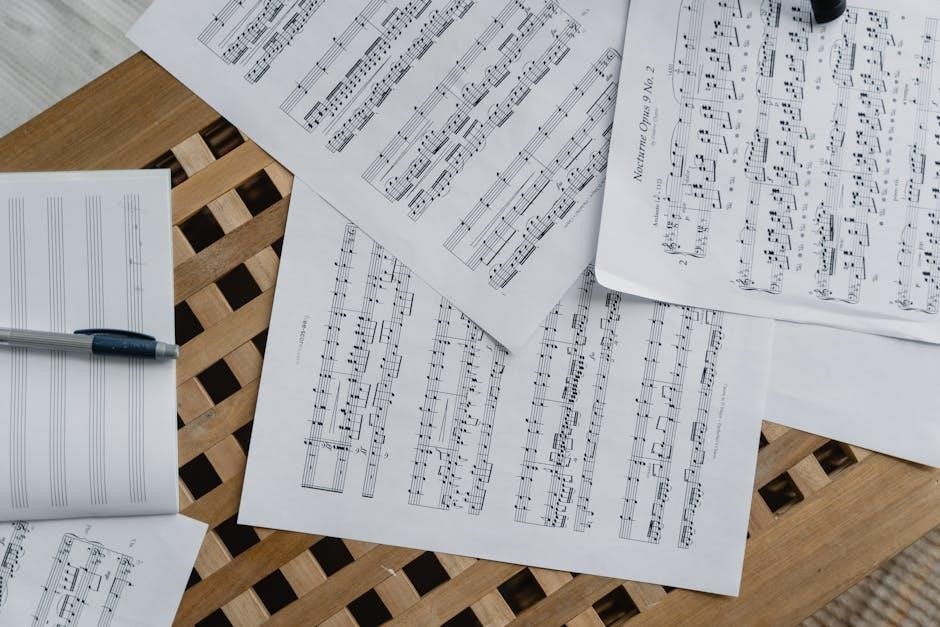
Cultural and Historical Significance
“Hallelujah” is a culturally significant song that transcends time, exploring themes of spirituality and humanity. Its enduring influence on music and popular culture remains unparalleled and timeless.
Biblical References and Themes
Leonard Cohen’s “Hallelujah” draws heavily from biblical narratives, particularly the story of King David and Bathsheba, weaving themes of love, regret, and redemption. The song’s lyrics reference biblical figures like Samson and Delilah, symbolizing strength and vulnerability. Cohen’s use of religious imagery, such as the hallelujah refrain, evokes a sense of spiritual longing and existential reflection. The interplay between sacred and profane themes creates a profound emotional depth, resonating with listeners on both a personal and universal level. This blend of biblical storytelling and poetic expression has cemented the song’s cultural and historical significance, making it a timeless exploration of human experience.
The Song’s Role in Popular Culture
Leonard Cohen’s “Hallelujah” has transcended its musical origins to become a cultural phenomenon, featured in films, TV shows, and live performances worldwide. Its emotional depth and versatility have made it a favorite for soundtracks, notably in movies like Shrek and The O.C.. Covers by artists like Jeff Buckley and Rufus Wainwright introduced the song to new generations, while its inclusion in various media cemented its status as a modern classic. The song’s ability to evoke powerful emotions has made it a staple in popular culture, resonating with audiences across genres and generations, ensuring its enduring influence on music and visual media alike.
Impact on Music and Artistry
Leonard Cohen’s “Hallelujah” has profoundly influenced music and artistry, becoming a benchmark for lyrical depth and emotional resonance. Its poetic complexity and versatility have inspired over 200 recorded covers, making it a cultural touchstone. The song’s success has elevated Cohen’s legacy, solidifying his reputation as a master songwriter. It has also shaped the careers of artists like Jeff Buckley, whose iconic rendition introduced the song to new audiences. “Hallelujah” continues to inspire musicians and creators, embodying the power of music to transcend time and genres, leaving an indelible mark on both contemporary and classical artistry.